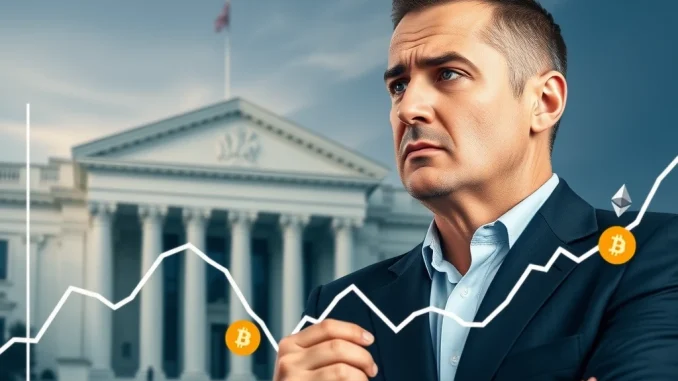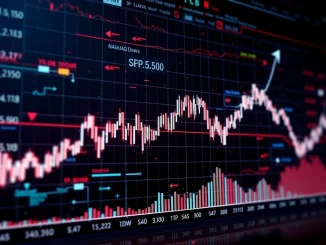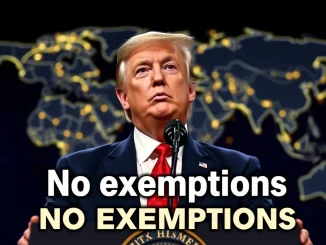
Cryptocurrency investors, are you bracing for a potential shift in the economic winds? Recent statements from Federal Reserve official Moussallem suggest that the eagerly anticipated Fed rate cuts might be further off than previously hoped. This news has significant implications for the crypto market, which often reacts strongly to changes in macroeconomic policy. Let’s dive into what Moussallem said and what it could mean for your crypto portfolio.
Why Fed Rate Cuts Could Be Delayed: Decoding Moussallem’s Message
In a recent report by CLS News, Fed official Moussallem highlighted two key factors that could push back the timeline for interest rate reductions:
- Robust Labor Market: The US labor market continues to show surprising strength. A tight labor market can lead to wage increases, which in turn can fuel inflationary pressures.
- Persistent Inflation Risks & Tariffs: Moussallem cautioned against dismissing tariff-driven price increases as merely temporary. He pointed out the potential for ‘second-round effects’ from tariffs, meaning the initial price hikes could trigger broader inflationary spirals.
Moussallem’s stance is a stark reminder that the fight against inflation is far from over. His words carry weight because they signal a potential shift in the Fed’s approach, moving away from the previously anticipated dovish stance towards a more hawkish, or at least, patient one.
Inflation Risks Remain Elevated: A Cause for Concern?
Inflation has been a persistent headache for global economies, and the US is no exception. While there have been periods of cooling inflation, Moussallem’s comments underscore the concern that inflation risks are still very much alive. Several factors contribute to this:
- Supply Chain Disruptions: Although easing, lingering supply chain issues can still contribute to higher prices.
- Geopolitical Instability: Ongoing global conflicts and tensions can impact energy prices and commodity markets, further fueling inflation.
- Strong Consumer Demand: Despite inflation, consumer spending remains relatively robust, supported by the strong labor market. This sustained demand can keep upward pressure on prices.
For crypto investors, persistent inflation is a double-edged sword. On one hand, some view cryptocurrencies like Bitcoin as a hedge against inflation. On the other hand, high inflation can lead to tighter monetary policy, which can negatively impact risk assets like crypto.
The Impact of a Strong Labor Market on Interest Rates
A strong labor market is generally seen as a positive economic indicator. However, in the context of inflation, it presents a challenge for the Federal Reserve. Here’s why a robust job market could delay rate cuts:
- Wage Growth: A tight labor market empowers workers, leading to increased wage demands. While beneficial for workers, rapid wage growth can contribute to a wage-price spiral, making inflation harder to control.
- Consumer Spending: Higher employment and wages translate to increased consumer spending. Strong demand can outstrip supply, leading to price increases.
- Fed’s Dual Mandate: The Fed has a dual mandate: to maintain price stability and maximize employment. A strong labor market might give the Fed more leeway to focus on controlling inflation, even if it means delaying rate cuts.
If the labor market continues to show resilience, the Fed might feel less pressure to cut interest rates quickly. This scenario could mean higher borrowing costs for longer, impacting economic growth and potentially dampening investor sentiment towards riskier assets like cryptocurrencies.
Tariffs and Their ‘Second-Round Effects’: What to Watch Out For
Moussallem specifically highlighted the potential for tariffs to have ‘second-round effects’ on inflation. This is a crucial point to understand:
- Direct Price Increases: Tariffs directly increase the cost of imported goods.
- Supply Chain Adjustments: Businesses may need to reorganize supply chains to avoid tariffs, which can be costly and lead to price increases.
- Wage-Price Spiral Potential: As import prices rise due to tariffs, businesses might pass these costs onto consumers. If workers then demand higher wages to maintain their purchasing power, it can trigger a wage-price spiral, further exacerbating inflation.
Moussallem’s warning about tariff-driven inflation suggests that the Fed is closely monitoring these trade policy impacts. If tariffs indeed lead to more persistent inflationary pressures, it strengthens the case for maintaining higher interest rates or even considering further tightening of monetary policy.
Interest Rates: Higher for Longer or Even Higher Still?
The central question for crypto investors and the broader market is: what does this mean for interest rates? Moussallem’s statement suggests a few possible scenarios:
- Higher for Longer: The most likely scenario, based on Moussallem’s comments, is that the Fed will maintain current interest rates for a longer period than previously anticipated. This means borrowing costs will remain elevated, potentially impacting economic growth and investment in risk assets.
- Potential for Further Hikes: Moussallem didn’t rule out the possibility of *tighter policy*. This suggests that if inflation proves to be even more stubborn or if the labor market remains exceptionally strong, the Fed might even consider *raising* interest rates further. While less probable, this scenario cannot be entirely dismissed.
- Delayed Rate Cuts: The prospect of near-term rate cuts has diminished. Investors may need to adjust their expectations and prepare for a higher interest rate environment to persist for the foreseeable future.
For the crypto market, higher interest rates generally translate to less attractive investment conditions. Investors may favor less risky assets offering fixed income, and borrowing costs for crypto projects and traders increase.
Navigating the Uncertainty: Actionable Insights for Crypto Investors
So, what should crypto investors do in light of these developments? Here are some actionable insights:
- Stay Informed: Keep a close watch on economic data releases, particularly inflation reports and labor market figures. Pay attention to Fed communications and speeches from officials like Moussallem.
- Risk Management: In a potentially higher-for-longer interest rate environment, prioritize risk management. Diversify your portfolio, consider hedging strategies, and be prepared for market volatility.
- Long-Term Perspective: Remember that market cycles are inherent in crypto. Focus on the long-term fundamentals of your investments and avoid making impulsive decisions based on short-term market fluctuations.
- Fundamental Analysis: In an environment of economic uncertainty, strong fundamentals become even more critical. Focus on investing in crypto projects with solid use cases, strong teams, and healthy tokenomics.
Conclusion: A New Chapter of Patience for Crypto and Beyond?
Moussallem’s message is clear: the path to lower interest rates may be longer and more uncertain than previously imagined. The strength of the labor market and the potential inflationary impact of tariffs are significant factors that the Federal Reserve is closely monitoring. For crypto investors, this means adjusting expectations, prioritizing risk management, and focusing on long-term strategies. The era of easy money might be fading, and a new chapter of patience and strategic navigation is likely upon us. Stay vigilant, stay informed, and navigate these economic shifts with caution and wisdom.



